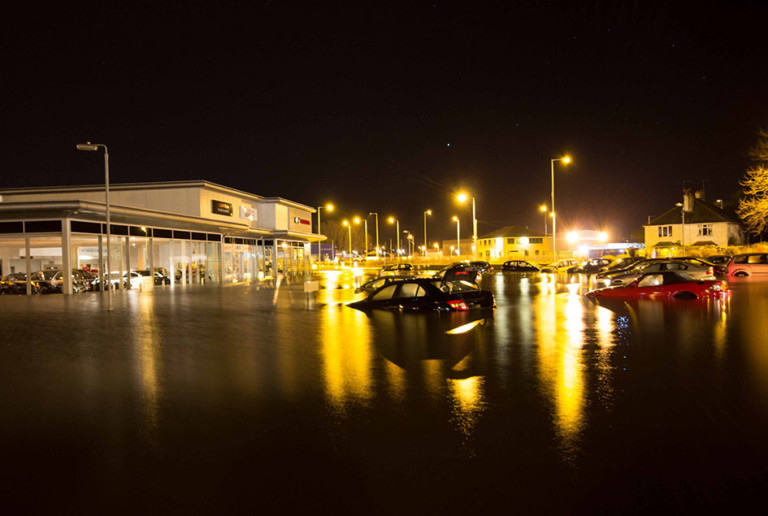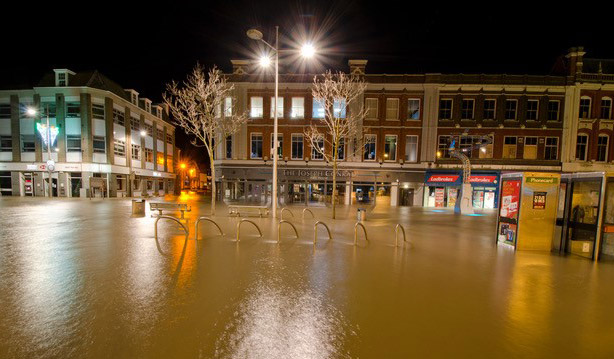Promising steps towards creating a more flood-resilient England

Although current risk reduction attention is on COVID-19, climate change-related hazards such as flooding continue to have impacts around the world. Here, Sara Mehryar, Viktor Roezer and Swenja Surminski evaluate new announcements on flood protection for England and report on their own work on the Suffolk coast.
While recent national and global efforts to reduce risk have focused wholeheartedly on the fight against COVID-19, it is important that work to improve the resilience of societies against climate-related risks continues alongside. Catastrophic flood events have been reported in Asia, Africa and North America during the pandemic; governments and societies need to recognise the importance and urgency of taking a holistic approach to resilience and increase their level of preparedness to manage compound risks.
New flood protection announcements are welcome but not enough on their own
It is encouraging to see the UK government recognising that flood risk management is an important investment area: we welcome recent announcements on spending and policy, including the new Flood and Coastal Erosion Risk Management (FCERM) policy on 14 July 2020, which assigns a budget of £170 million to 22 at-risk areas in England to accelerate ‘shovel-ready’ flood protection projects. These projects will commence in 2020 and 2021, and are intended to provide a boost to businesses and economic growth as part of the economic recovery from COVID-19. The Government has also committed to double investments in the flood and coastal protection programme in England over the next six years to £5.2 billion, to protect a further 335,000 properties in England by 2027.
While acknowledging the recent funding announcements, it is important to recognise that investments in large-scale flood protections will take time to materialise and will never completely remove flood risk. Therefore, it should be kept in mind that flood protection is never absolute and may even create a false sense of security, as it tends to stop other complementary risk reduction and adaptation activities from going ahead. Considering the concept of residual risk, including the potential failure or breach of flood defences, it is important to continue with holistic resilience efforts, including property-level protection measures and nature-based solutions.
Holistic approaches to adaptation and flood risk management
In the UK, the Grantham Research Institute has been actively working with national-level policymakers and stakeholders to promote the holistic and forward-looking resilience approach for climate change adaptation and flood risk management. For example, in recent submissions to the Environment Agency (EA) and Department for Environment, Food and Rural Affairs (Defra) we have encouraged an urgent multi-systems approach – this means that flooding is a multi-faceted phenomenon that can only be tackled through a broad array of measures that extend beyond the domain of engineers, hydrologists and statisticians. Enhancing flood resilience requires ensuring that all necessary social, human, natural, physical and financial systems are in place to mitigate future flood risks. We therefore call for investment in nature-based solutions, community-level planning, education and awareness-raising, spatial planning and property-level protection measures in order to increase flood resilience.
We also emphasised in these consultation responses the needs to include climate change in future flood risk assessment and planning, decrease the risk of surface water flooding, revisit land-use policies in flood-prone areas, and enhance effective communication of the ‘co-benefits’ of flood resilience interventions: in addition to avoiding irreversible losses, investment in resilience can help unlock economic growth, and, if done smartly, help unlock social and environmental benefits. For example, the use of nature-based flood management approaches helps to restore local environments and provide carbon sequestration. This creates a positive narrative for flood resilience as an investment in the future of our communities.
It is promising to see this wider resilience language in the recent FCERM Policy, as well as in the Defra report on the Evidence Review of the Concept of Flood Resilience (which reviews the concept of flood and coastal erosion resilience and how it can be used in a resilience framework for managing flood and coastal erosion risk management in England and Wales).
As for long-term planning and taking actions to tackle climate change, the FCERM policy outlines five ambitious policies and more than 40 supporting actions to increase resilience and prepare the country for future flood risk and coastal erosion. These actions aim to reduce both the likelihood and impacts of future flooding and include measures backing natural solutions – for example, creating sustainable drainage systems and building hollows in the ground to catch flood water in heavy rains, enhancing resilience incentives for property owners through the Flood Re insurance pool, and enhancing planning policies to direct new development policies away from areas at risk. £200 million of the flood budget will be allocated to support the implementation of these actions in 25 local areas in England.
Supporting resilience decision-making on the east coast of England

The town of Lowestoft on the North Sea coast in Suffolk, a local partner of the Zurich Flood Resilience Alliance (ZFRA), has received the largest part of the funding for flood protection, at £43.5 million. The Grantham Research Institute has worked in close collaboration with East Suffolk Council as part of the ZFRA project, to assess community flood resilience, identify challenges and weaknesses, consult on funding allocations, and to support decision-making for enhancing flood resilience in Lowestoft.
A clear understanding of local strengths and weaknesses is essential for anyone involved in flood risk management. We have been measuring community-level resilience in the area using the Flood Resilience Measurement for Communities (FRMC), developed and tested by the ZFRA across nine countries and 110 communities around the world. Carrying out resilience measurement in two time-series (a baseline in 2020 and end line in 2022) helps the local authorities to understand how the communities’ resilience in Lowestoft is changing over time and what the impacts of new measures and externalities, such as COVID-19, will be on local flood resilience. Our joint activities have already encouraged some local stakeholders (including Anglian Water and Groundwork East) to re-allocate their funding to flood resilience interventions being recommended by the ZFRA project over the next two years.
Collaboration between local experts, community members and researchers can help identify priority areas and support strategic action to increase flood resilience. We are working with the Coastal Partnership East, analysing additional co-benefits of flood resilience – such as economic, social and environmental wins – to help better align investments in flood risk management with wider development needs in the region, including tourism and urban regeneration efforts. Using the ‘triple dividend of resilience’ framework developed with colleagues at the Overseas Development Institute and the World Bank, this joint work focuses on improving decision-making and supporting the wider business case for flood resilience.
Moving forward – flood resilience in broader risk management planning
Looking to the future, the importance of considering flood resilience in broader risk management planning, where several shocks might occur simultaneously, must be recognised and addressed. This is particularly important in the current COVID-19 crisis, which will have direct implications over the months and years to come. COVID-19 requires urgent action from researchers to develop evidence and guidelines for policymakers on how to build multi-risk resilience while responding to the current crisis.
As we propose here, flood risk management needs to move beyond the traditional view of relying solely on ‘hard’ engineering and infrastructure solutions. Rather, a holistic resilience approach including strategies for increasing human, social and indeed natural capacities is urgently needed for building such a multi-risk resilience for communities.
This commentary was originally published by Business Green. The views in this commentary represent those of the authors and do not necessarily represent those of the Grantham Research Institute.

